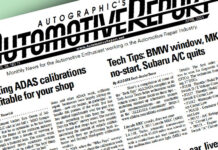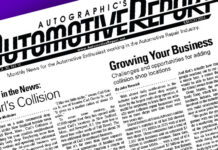News and trends related to the insurance industry that could have impact on repairers
By John Yoswick
What’s happening in the world of auto insurance can have a day-to-day impact for collision repairers.
For example, here’s good news if you prefer claims being paid for by Progressive Insurance or Geico, and less positive news if you prefer those covered by State Farm. Progressive saw another year of stunning growth in premiums and market share in 2019, outpacing even Geico. That growth came largely at the expense of State Farm’s market share.
Despite the incredible growth of Geico and Progressive over the past 15 years, State Farm until two years ago had been mostly unaffected, maintaining a firm hold on its No. 1 spot, with a steady 18 percent share of the U.S. personal auto insurance market, while smaller competitors slowly lost customers to Flo and the Gecko. But it’s been a different story since 2018. In that year, State Farm’s premium growth remained practically flat over the prior year while Geico grew its total premiums almost 12 percent, and Progressive wrote nearly 19 percent more in premiums. The result was an unprecedented loss of more than a full percentage point of State Farm’s market share to its competitors. A single percentage point of market share may not sound like a lot, but it represents more than $2.5 billion dollars in premiums written.
In the 2019 auto insurance premium data released this year by the National Association of Insurance Commissioners (NAIC), State Farm once again lost another 1 percentage point of personal auto insurance market share. While Geico saw its total premiums rise 5.5 percent from 2018 to 2019, and Progressive’s total premiums increased 14.7 percent, State Farm saw its total premiums drop 2.6 percent, leaving the insurer with just over 16 percent of the auto insurance market, its lowest share in decades.
Insurance industry analyst Brian Sullivan said he also sees State Farm at a “crossroads.”
“No company has ever lost a full point point of market share [in a single year] in auto insurance. State Farm has bounced back before. But this feels different,” Sullivan said.
While it’s unlikely Geico and Progressive’s growth rates will continue unabated, Sullivan noted, if they did, they would both catch up to State Farm by 2021.
“State Farm has to do something bold, though bold is not what they do,” Sullivan said. “They are going to have to break the mold. Sell direct [rather than just through agents]. Lower their expenses. Change the way they do claims. Something big.”
Progressive, currently the third largest insurer in the country, once again grew the fastest in 2019 among the 25 largest insurers in the country, jumping from 10.9 percent market share in 2018 to 12.3 percent last year.
But the growth rate of the second largest insurer, Geico, has outpaced all others over the past decade, with Geico gaining 5.6 percent of market share since 2009, compared to Progressive’s 4.8 percent gain.
Others gaining market share last year included Allstate (No. 4) and USAA (No. 5), American Family (No. 9) and Travelers (No. 10).
That contrasts with companies like Farmers (No. 7) and Nationwide (No. 8), which have been slowly losing market share over the past 10 years, each giving up more than 2 percent market share to their competitors.
Combined, the Top 10 insurers collected 73 percent of the $253 billion in annual personal auto insurance premiums paid by American drivers in 2019, according to the NAIC numbers. That is up from 68 percent a decade ago. The top four largest insurers — State Farm, Geico, Progressive and Allstate — together now control more than half (51.5 percent) of the entire auto insurance market.
Grading the insurers
For body shops who see in a difference in how some insurance companies handle claims compared to others, the annual “Insurer Report Card,” offers a way to help them communicate that to drivers who during a tough economy may be shopping for insurance.
CRASH Network’s 2020 “Insurer Report Card” found that shops tended to give smaller and regional companies better marks. The five highest-graded insurance companies, for example, included North Carolina Farm Bureau (the only company to receive an “A+”), Erie Insurance (A-), Acuity Insurance (B+) and Oregon Mutual (B+). Those four companies were in the Top 10 the last time the “Insurer Report Card” was conducted, in 2017.
Among the 10 largest private auto insurance carriers, only one — Travelers (ranked #49 with a “C+”) — was among the top 50 in this year’s survey rankings. Three of the largest insurers — Geico, Liberty Mutual/Safeco and Allstate — received a “C-“ and were among the 11 lowest-graded insurers.
More than 1,000 shops participated in the 2020 “Insurer Report Card,” grading as many as 30 insurers in their state on a scale from “A+” to “F” in terms of how well each company’s “policies, attitude and payment practices ensure quality repairs and customer service for motorists.” In all, the survey reported grades for 79 insurance companies, findings that could help introduce consumers to insurance companies they might not be as familiar with but that offer superior claims service, according to shops.
Participating shops were also asked to identify the insurer direct repair programs in which they participate. For the Big 10 largest personal auto insurers, their DRP facilities awarded them, on average, a grade two-thirds higher than non-DRP shops awarded the same insurer. USAA saw the biggest such difference, with its DRP shops giving the company an “A-” compared to the “C+” USAA received from shops not participating in the company’s direct repair program. American Family, however, stood out here for a different reason: Its DRP shops gave that insurer a “C,” no better a grade than the subset of shops that aren’t part of American Family’s DRP gave the insurer.
The 2020 “Insurer Report Card” findings are available for downloaded online (https://www.crashnetwork.com/irc).
Getting inside insurance company executives’ heads
Industry consultant Roger Wright of Vector Squared last year reported on interviews he’d done with high-level auto claims executives at eight Top 20 insurance companies. The interviews, commissioned by Akzo Nobel, started with Wright asking each claims executive what keeps them up at night, followed by an open discussion of whatever topics were of interest to that insurer.
Wright said the insurers’ concerns could be lumped into eight or nine categories; not surprisingly, “collision repair relationships” was one of those. The insurers generally said they like working with MSOs in that larger repair organizations can offer a single point of contact, may operate call centers, and generally have standard operating procedures in place. Service level agreements with MSOs have become common, with MSOs largely managing their own claims for an insurer based on agreed-upon targets for severity, cycle time, CSI etc.
But perhaps surprisingly, Wright said some of the insurers voiced discontent with large MSOs. They have too much staff turnover, some insurers said, and repair quality and customer service can vary too much from location to location. A lack of trust is still prevalent, and insurers said they would prefer not to select an entire MSO as a group but choose among an MSO’s individual locations. They actually would prefer to work with single-shop operators or regional MSOs.
They also expressed concern something many in the industry have wondered about: That they see the largest MSOs getting big enough to begin leveraging their size to the disadvantage of insurers.
More recently at a gathering of auto insurance claims executives, Wright posited that some insurer-repairer friction could be based on insurers’ failure to capture and use real-time data in underwriting. As an example, he pointed to a Kia K900, a vehicle with a $50,000+ retail price.
“Just the headlights and taillights alone, if you were just paying for two headlights and two taillights, it’s $15,000,” Wright said.
But underwriters, he said, are basing premiums for that vehicle on the $34,000 Kia Cadenza.
“A front-end hit, no structure, is $34,000,” Wright said. “It’s a total loss that’s being underwritten. We don’t know that upfront because we’re not using the data. How long do our actuaries take to formulate their triangles? Three to five years? During that time, we’re getting killed on severity. And of course, it’s the claims department’s problem when [the company] gets killed on severity. And then the claims department blames the body shops.”
Wright also said insurers are finding that automated photo-based estimating technology still has short-comings. He said some years ago he’d worked with a company building predictive analytic models.
“We got pretty accurate on the front-end [hits], but [less so] as soon as you went to the rear of the car, because of the rear body panel with the distortion that photos just didn’t show,” he said.
One problem could be the historic estimate data the systems are using.
“Everybody’s got lots of data,” Wright said. “But how much of that is actually accurate data? Or is it an estimate that got written and uploaded but [the vehicle] was never fixed?”
In those cases, Wright noted, the estimate the system is using to “learn” could be “100 percent wrong” because the customer cashed-out and there was no supplement.
“That’s the data that was used to build the analytic models,” Wright said.
Supplements on automated estimates, he said, still constitute a much higher percentage of the initial estimate than those for more traditionally written estimates.
“They’re not quite there yet,” Wright said.
Supplements are becoming larger and more common
Indeed, if it feels like your shop has been writing more – and larger – supplements in recent years, new data backs that up.
CCC Information Services recently released numbers showing that the size of supplements, when represented as a percentage of the final repair cost, have risen from an average of 10.4 percent in 2010 to 18.1 percent of all supplemented estimates in the CCC system last year. That rise of nearly 8 percentage points represents a 74 percent increase in the relative size of supplements. (The increase is unrelated to inflation or rising severity as it is the relative percentage of the final estimate amount, not affected by any increase in dollar amount.)
The percentage of estimates for which supplements were submitted has increased as well. Over the past nine years, the percentage of estimates resulting in a supplement has risen from 47.1 percent to 55.6 percent; that eight percentage point rise represents an 18 percent increase in estimates for which there was a supplement.
Combined with the 74 percent increase in the relative size of supplements, the total average percentage of all estimate dollars paid through supplements has more than doubled in less than a decade. •
John Yoswick, a freelance writer based in Portland, Ore., who has been writing about the automotive industry since 1988, is also the editor of the weekly CRASH Network (www.CrashNetwork.com). He can be contacted by email at john@CrashNetwork.com.



